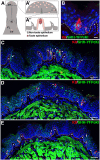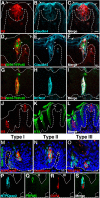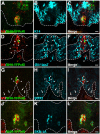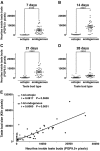Induction of ectopic taste buds by SHH reveals the competency and plasticity of adult lingual epithelium
- PMID: 24993944
- PMCID: PMC4197660
- DOI: 10.1242/dev.107631
Induction of ectopic taste buds by SHH reveals the competency and plasticity of adult lingual epithelium
Abstract
Taste buds are assemblies of elongated epithelial cells, which are innervated by gustatory nerves that transmit taste information to the brain stem. Taste cells are continuously renewed throughout life via proliferation of epithelial progenitors, but the molecular regulation of this process remains unknown. During embryogenesis, sonic hedgehog (SHH) negatively regulates taste bud patterning, such that inhibition of SHH causes the formation of more and larger taste bud primordia, including in regions of the tongue normally devoid of taste buds. Here, using a Cre-lox system to drive constitutive expression of SHH, we identify the effects of SHH on the lingual epithelium of adult mice. We show that misexpression of SHH transforms lingual epithelial cell fate, such that daughter cells of lingual epithelial progenitors form cell type-replete, onion-shaped taste buds, rather than non-taste, pseudostratified epithelium. These SHH-induced ectopic taste buds are found in regions of the adult tongue previously thought incapable of generating taste organs. The ectopic buds are composed of all taste cell types, including support cells and detectors of sweet, bitter, umami, salt and sour, and recapitulate the molecular differentiation process of endogenous taste buds. In contrast to the well-established nerve dependence of endogenous taste buds, however, ectopic taste buds form independently of both gustatory and somatosensory innervation. As innervation is required for SHH expression by endogenous taste buds, our data suggest that SHH can replace the need for innervation to drive the entire program of taste bud differentiation.
Keywords: Cell lineage; Mouse molecular genetics; Regeneration; Taste.
© 2014. Published by The Company of Biologists Ltd.
Figures






References
-
- Bai C. B., Auerbach W., Lee J. S., Stephen D., Joyner A. L. (2002). Gli2, but not Gli1, is required for initial Shh signaling and ectopic activation of the Shh pathway. Development 129, 4753-4761. - PubMed
Publication types
MeSH terms
Substances
Grants and funding
LinkOut - more resources
Full Text Sources
Other Literature Sources
Molecular Biology Databases
Research Materials

